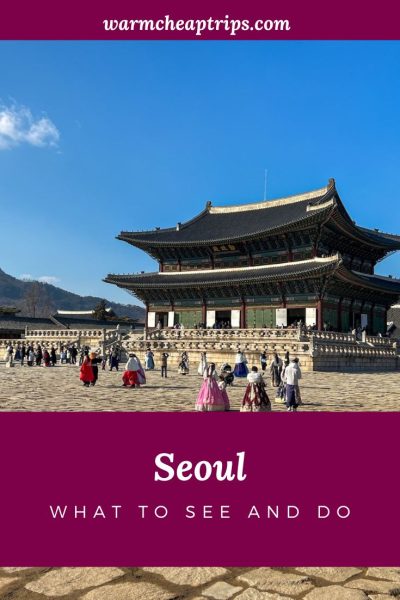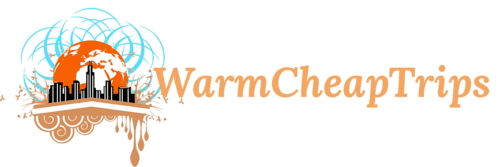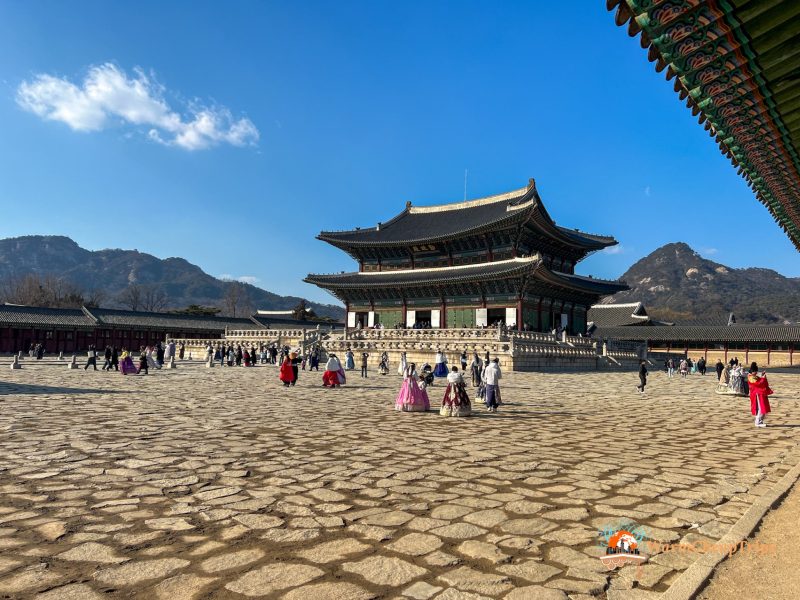Seoul is the capital of South Korea and, of course, an essential stop on any itinerary in the country. A city that has evolved tremendously in recent decades, transforming into a modern metropolis, home of K-pop and the latest beauty trends. But Seoul is also made of historic sites (yes… sometimes turned into photo sets, but fine), retro cafés loved by locals, and lots and lots of contradictions.
Unlike my usual posts on things to see in a city, this article won’t be too complete or detailed — mostly because Seoul and I didn’t exactly click (so forgive me if the level of enthusiasm isn’t my usual!), and also because I visited in winter, forcing me to be selective with what to see. Harsh temperatures required more indoor “warm-up breaks.”
But even though Seoul is not among my favorite destinations, I will surely have the chance to return and update this article with more places to see in Seoul.
What to see and do in Seoul
You could easily spend an entire week in Seoul, even using it as a base for day trips to places like Suwon or the DMZ. But generally, in a South Korea itinerary, travelers spend 3–4 days in the capital — just like we did. We actually spent 3 and a half full days when we arrived, plus another half-day with an overnight stay in a traditional hanok after visiting Andong, before returning to Japan. Since it was winter, we couldn’t visit everything I had planned — but in a different season, four days in Seoul are perfect, including the half-day excursion to the border with North Korea.
In our case, we actually spent three and a half full days in Seoul upon arrival, plus another half day with an overnight stay in a traditional hanok after visiting Andong, before flying back to Japan. Since we were traveling in winter, we couldn’t manage to see everything I had initially planned, but I’d say that in a different season, four days in Seoul are perfect — even if you include a visit to the border with North Korea, which usually takes up about half a day.
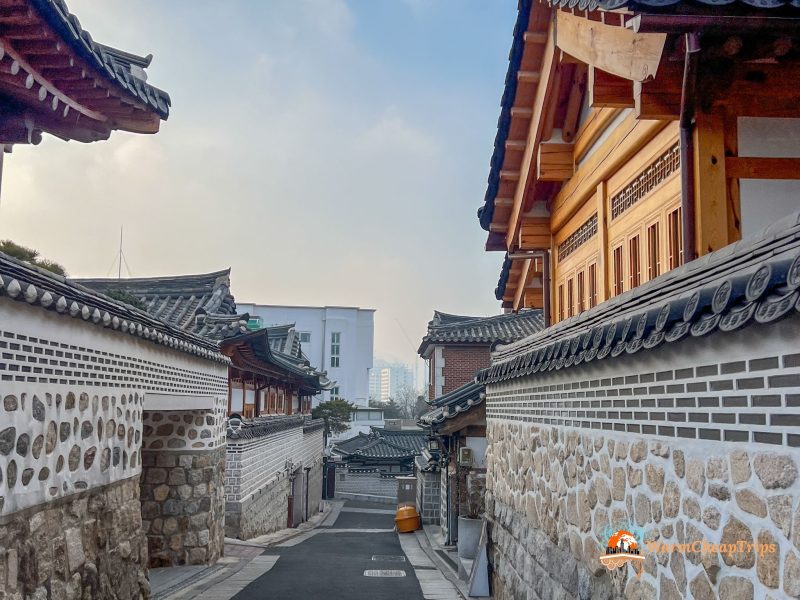

Day 1 — Insadong & Ikseondong
It takes just over an hour to reach central Seoul from Incheon Airport even by the regular subway (which costs a quarter of what the recommended AREX express train does — and only takes about 10 minutes longer!).
After dropping off luggage at the hotel, we start familiarizing ourselves with the city by strolling through nearby Insadong and Ikseondong, where tradition meets modernity: artisan shops, tea houses, clothing boutiques, and traditional hanok converted into trendy stores. Locals and tourists blend together, and cafés and tea houses mix traditional Korean elements with Instagram-friendly décors.
Here you’ll also find Jogyesa Temple and its colorful lanterns. You can join temple activities and enter the restricted area for worshippers — at night the temple is illuminated and very atmospheric.
On the edge of Ikseondong lies Jongmyo Shrine, a UNESCO World Heritage site. It can be visited for free with a guide, allowing you to better understand this shrine dedicated to Korean kings. Unfortunately, we visited on a Saturday, when guided tours are only in Korean. On other days, English tours run at 10:00, 12:00, 14:00, and 16:00. It costs 1,000 won, is open 9:00–16:30 (17:30 in summer), and lasts about 1 hour.
The plan was then to head up to N-Seoul Tower, but cold and travel fatigue won — so we ended the evening in a tiny local spot in the Jongno-3ga area, where we had dinner for very little and the best chijimi of the whole trip!
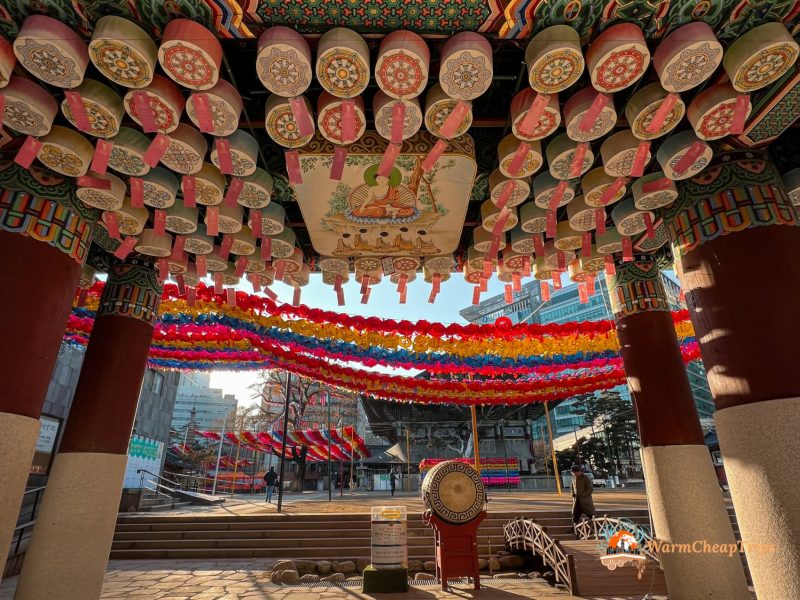

Day 2 — Seoul’s Imperial Palaces
If you wear the hanbok, Korea’s traditional attire, you get free entry to Seoul’s Royal Palaces — so despite the cold, we dedicated this day to history and rented hanbok for the entire day.
Luckily, the palaces are all close to each other — reachable on foot or by a short, cheap Uber ride.
All royal palaces also offer free guided tours in English at set times. We joined them at both the largest and most famous Gyeongbokgung, and the beautiful Changdeokgung (a UNESCO site). Since it was winter, we skipped the Secret Garden (paid entry even with hanbok and only accessible by tour booking), and instead visited Changgyeonggung.
We rented hanbok from Klook — go first thing in the morning for the widest choice of colors and patterns. Klook has more rental shops available, but GetYourGuide has options too — using the promo code WARMCHEAPTRIPS5 on the app gives you 5% off.
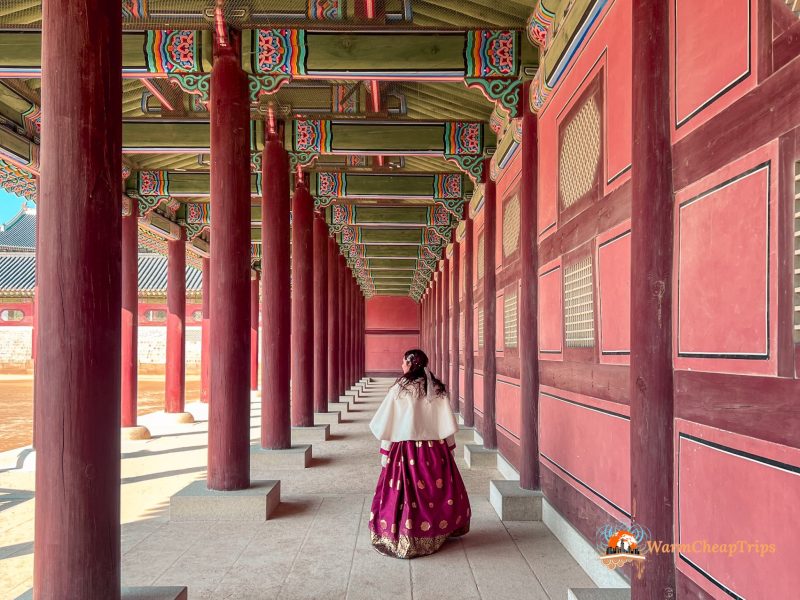

Undoubtedly, Gyeongbokgung is the biggest and most crowded one, with the famous red columns — probably the most photographed background for hanbok pictures. It’s really large, so much so that even with the guided tour you only get to see a part of it! Plan at least a couple of hours even without the guided tour, but personally I recommend joining it because you’ll learn a ton about Korean history and you’ll be given a lot of information about the details and the architecture of the palaces.
Entrance to Gyeongbokgung costs 3,000 won (free if you’re wearing a hanbok) and it’s open from 9:00 to 17:00. I’ll also note that at 10:00 and 14:00 you can watch the guard changing ceremony at the main gate.
The English guided tours are at 11:00, 13:30 and 15:30 and last 90 minutes.
My favorite, however, is Changdeokgung, where we joined another guided tour — this time in Japanese because it fit our schedule better — and our lovely guide kept wanting to take photos of us because we were the only couple in hanbok on the tour, and she was thrilled about it!!
I especially liked the final part of the tour, maybe because it’s less colorful but very elegant, with lots of wood and traditional architectural elements.
Here you’ll also find the Secret Garden, which everyone says is beautiful, and it can only be visited on a guided tour, at set departure times, for an additional 5,000 won fee. Spots are limited and sell out quickly, so it’s best to book in advance through this website.
Entrance to Changdeokgung costs 3,000 won (free if you’re wearing hanbok) and it’s open from 9:00 to 16:00.
English guided tours are at 10:15 and 13:15 and last 90 minutes.
Changdeokgung and the entrance to the Secret Garden are also connected to Changgyeonggung, the Imperial Palace built for King Seongjong’s grandmother, mother, and aunt. This is the one where we definitely found the fewest people, and where we missed the guided tour by just a few minutes, so we didn’t join it!
We still took the chance to snap some nice photos without other people in the frame. At this palace, during certain times of the year, it’s possible to enter for free in the evening during special night illuminations — I recommend checking the official website.
In this case too, the cold got the better of us — also because yes, we were wearing thermal layers and sweaters under the hanbok, but no down jacket on top! — so we gave up on the idea of having dinner at a market like Gwangjang or Tongin, opting instead for a warm Budae-jjigae not far from Cheonggyecheon Stream.
Speaking of markets, I feel like I should advise against the Myeongdong Night Market because it seems to be quite a tourist trap, with inflated prices and mediocre quality.
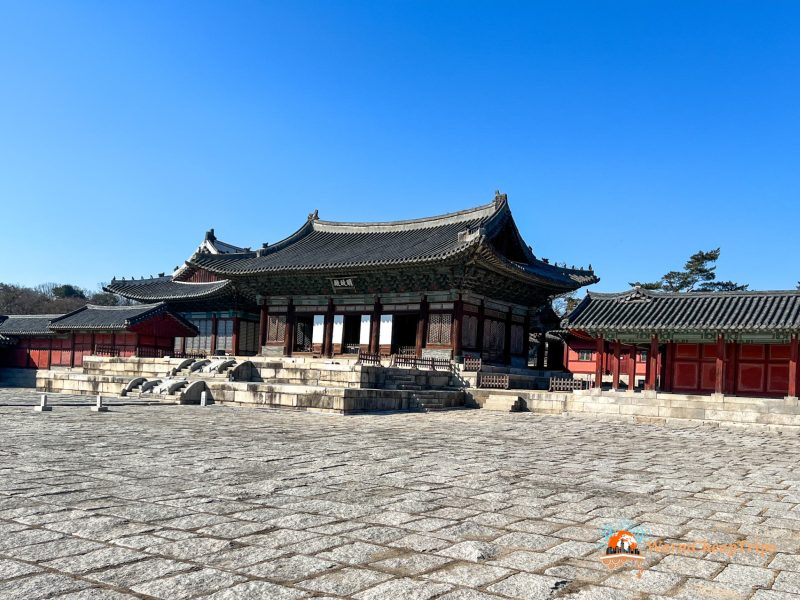

Day 3 — Seodaemun Prison, War Memorial of Korea, & Hongdae
After the day dedicated to the imperial palaces and Korea’s ancient history, the journey continues with Korea’s more modern history, visiting Seodaemun Prison, used mainly by the Japanese during the occupation. Honestly, I didn’t really like the very propagandistic narrative aimed solely at fueling hatred towards Japan. Of course, the Japanese occupation period was terrible for many Koreans fighting for independence, and the Japanese certainly didn’t go easy with their punitive treatments, but I believe history should be told impartially, narrating events objectively and free from any biased judgment for one side or the other. An example of a prison where incredible tortures also occurred, but where I found a less politicized narrative, was Hoa Lo Prison in Hanoi—a sign that things can be done differently, without diminishing the terrible things that happened.
Another essential stop to learn about and delve deeper into Korea’s history is the War Memorial of Korea, a museum that traces the history of Korea’s wars from the Three Kingdoms period, to the Japanese occupation, all the way to the Korean War. If you love history like I do, you’ll spend at least a couple of hours here reading the various in-depth explanatory panels, which, here too, are quite politicized.
After such an intense first half of the day, I recommend lightening the mood by visiting Hongdae, the youthful neighborhood, full of clothing and cosmetic shops, street food, and restaurants. Personally, I really liked this area; I found it to be a perfect representation of young and modern Korea, very authentic and not overly touristy, unlike Myeongdong, which seems very touristy with inflated prices and even some scams!
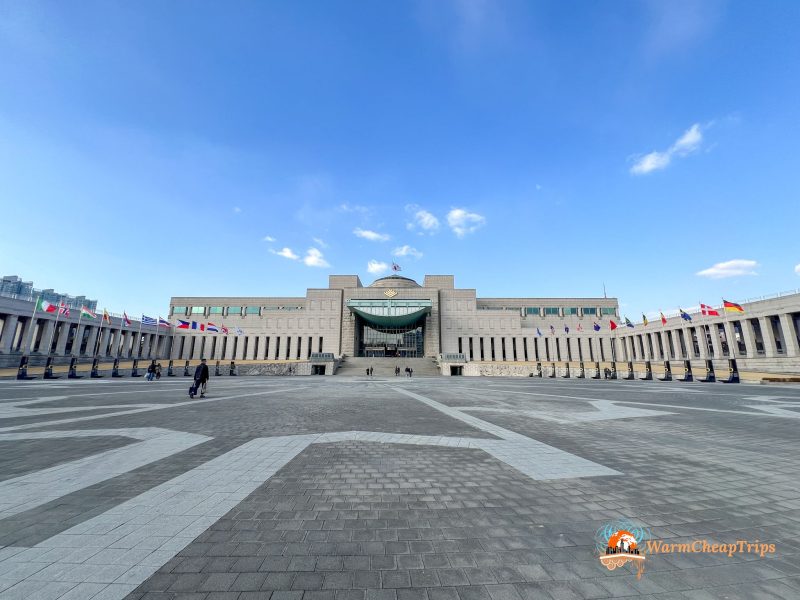

Day 4 — Day Trip
It’s possible to take several day trips from Seoul, and among them all, the most unique one—which I personally urge you to take—is the visit to the DMZ, the demilitarized zone between the two Koreas. This area can only be visited accompanied by an authorized guide, and you will need to present your passport for security checks. The excursion starts early in the morning, there are specific schedules, and there is always the uncertainty that the tour might be interrupted or that some areas could become inaccessible.
We opted for the half-day tour purchased through Get Your Guide, but there are also full-day tours that include a visit to a suspension bridge or a boat ride. By the way, by downloading the app and entering the code WARMCHEAPTRIPS5, you’ll get a 5% discount.
The tour itineraries are generally always the same; the times or the order might vary, and unfortunately, some tours are more focused on shopping than on explanations. I chose this tour after researching various agencies and reading many reviews, and I am satisfied with the one I picked. Needless to say, the guide makes a huge difference: Julie was fantastic and explained the history to us in an impartial and non-propagandistic way, while still being very detailed and thorough.
I will talk more about the DMZ excursion from Seoul in a dedicated article.
After the half-day excursion, we returned to the hotel to rest after the early wake-up call, partly because we had plans to meet a friend for dinner. Alternatively, this would have been the afternoon/evening dedicated to “crossing the river to visit the affluent Gangnam district, with K-Star Road and its statues of Korean idols, the enormous Gangnam Style hands, and the Starfield Library in the massive COEX shopping complex.
In the area, I’ll also mention Bongeunsa Temple, which I hope to have the chance to visit on a future trip.
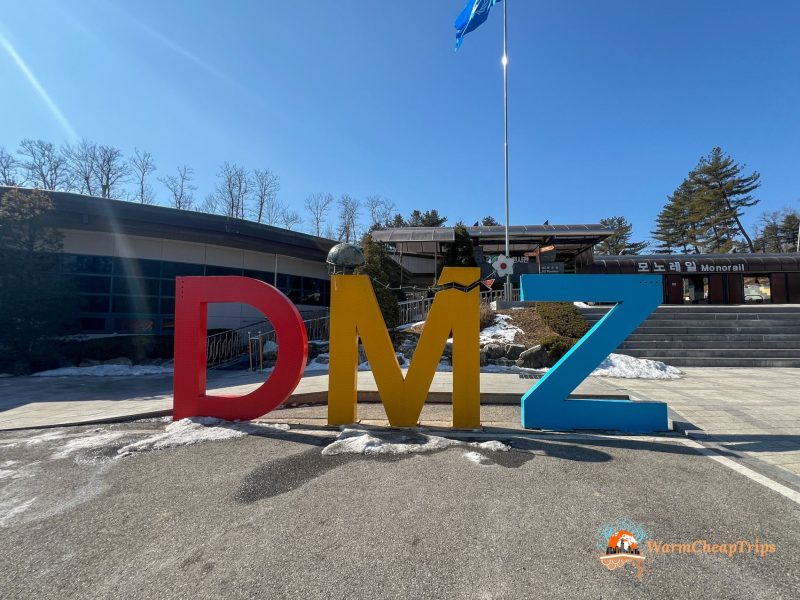

Where to Stay in Seoul
Myeongdong is often the most recommended area to stay in Seoul, but after digging a little deeper, I realized it wasn’t the right solution for my needs, as it’s heavily focused on nightlife, shopping, and, above all, very touristy. After consulting with friends who had been to Seoul several times, the choice fell on the Jongno 3-ga neighborhood, which is well-connected by public transport and from where you can also walk to the Imperial Palaces and the Insadong and Ikseondong areas.
We stayed at the Amare Hotel Jongo, which, incidentally, several followers on Instagram later wrote to tell me was also their choice in Seoul. A very large room, with a beautiful modern bathroom, spacious shower, bathtub, and excellent amenities. Very large and soft bed, breakfast included (though not very varied), 475,000 won for 3 nights.
However, I also recommend trying one night in a traditional hanok in Bukchon Hanok Village, which is in the same area as the Imperial Palaces. This way, you can enjoy the beauty of the hanok village in the evening and early morning, when tourist access is supposedly restricted!
Hanok are traditional Korean houses, made of wood and designed according to Feng Shui principles, creating harmony between the interior and exterior. They are simple dwellings where you sleep on the floor, on the pavement heated by the traditional Korean system called ondol. Generally, there is a small garden/internal courtyard, around which the rooms are arranged—usually simple, sparse, and often with a shared bathroom, featuring the typical heated floor.
We spent our last night at Bukchonae, for 130,000 won without breakfast. The room is tiny, with just enough space for the futons, a small table, room for luggage, and a small private bathroom (which is not a given in hanoks). I must say, with the underfloor heating, sleeping on the floor was fantastic, although a bit harder than the typical tatami rooms in Japan. Upon entering, there is a small internal courtyard, and shoes must be left out here in the external shoe rack—so they are quite cold in the morning! Nonetheless, the atmosphere is lovely, and there is a communal kitchen available.
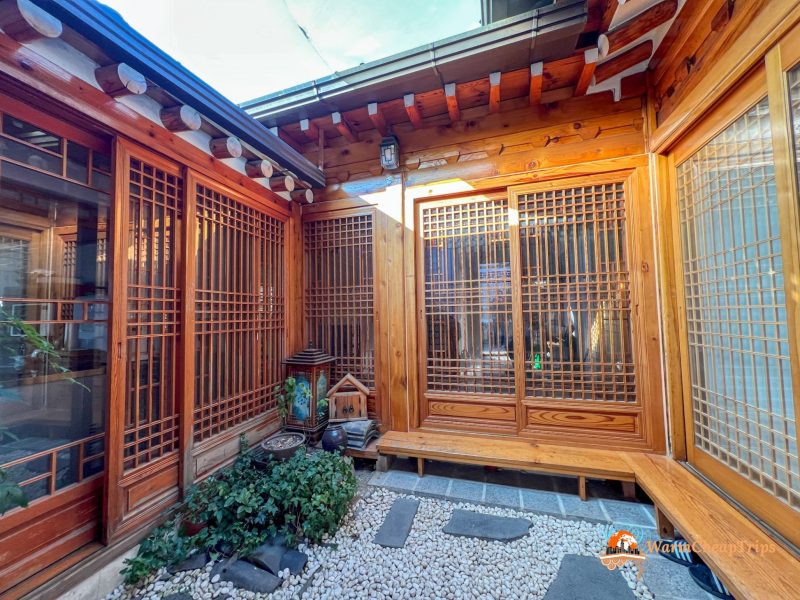

Where to Eat in Seoul
Food is undoubtedly an important part of a trip to Korea, especially in Seoul, where the sheer quantity of stimuli and available venues is enormous. Unfortunately, having visited Seoul in winter, I didn’t get to fully appreciate the street food in Hongdae, nor the stalls that pop up in the evening on many of Seoul’s streets.
Furthermore, you know I’m not the best person for culinary recommendations, as I generally choose where to eat almost at random, depending on where I am and the menus that inspire me at that moment. However, having found some real gems, I wanted to share them with you.
Meoureum – A delightful traditional tea house in an Insadong hanok, where an elderly couple serves tea and traditional sweets. A super traditional atmosphere and a truly delicious omijacha.
Nakwon – Another hanok converted into a café, this one in the Ikseon-dong hanok district, famous for its “tracks” in the inner courtyard and for the desserts that rotate on a conveyor belt. It’s quite well-known and therefore usually crowded.
Gaesong Traditional Dumpling House – Staying in the Insadong area, this restaurant is listed in the Michelin guide as a Bib Gourmand. You can’t make reservations; you have to queue (or, like us, get lucky and find a spot for dinner by going early). It’s a place that makes traditional dumplings from Kaesong, the North Korean town closest to the border. This is because the “nonnina” (grandmother) who opened the restaurant arrived from that city in 1970. The dumplings are huge and delicious; I suggest ordering the mixed plate.
Jungdamun Bukchon – This restaurant is actually beloved by the Japanese (so much so that the staff also spoke Japanese) and specializes in bossam, boiled pork that is eaten wrapped in lettuce leaves. Located in a converted hanok in Bukchon village, it’s an elegant and clean establishment, but be prepared for a bit of a wait.
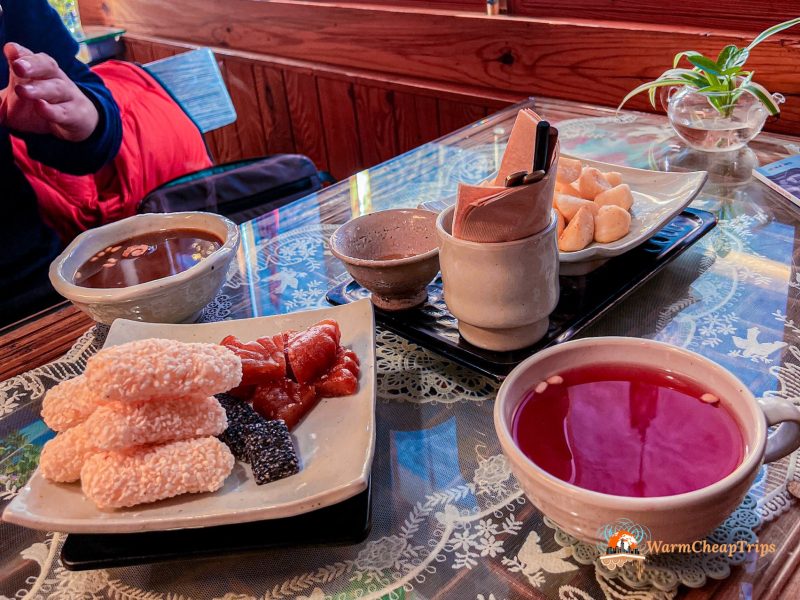

As mentioned, I didn’t get to see everything I wanted to in Seoul, and this article isn’t complete, as there are many other things to visit in South Korea’s capital. I will most likely have the chance to return to Seoul again and will update the article then. In the meantime, leave me a comment with the things you think are must-sees!
Did you find this article useful? Buy me a coffee 🙂
